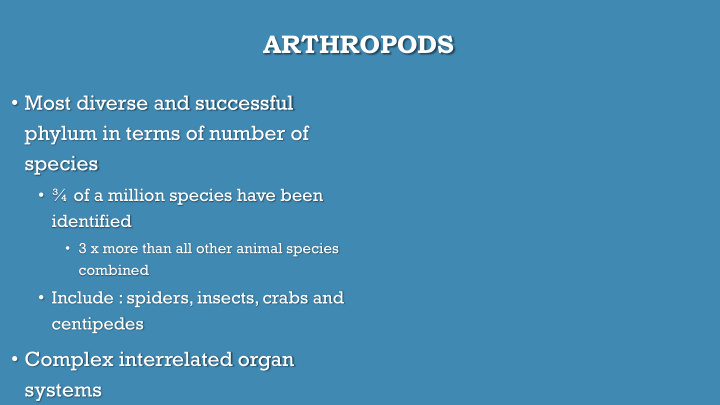



ARTHROPODS • Most diverse and successful phylum in terms of number of species • ¾ of a million species have been identified • 3 x more than all other animal species combined • Include : spiders, insects, crabs and centipedes • Complex interrelated organ systems
UNIFYING CHARACTERISTICS • Segmented bodies • # varies among groups • Tough exoskeleton • Jointed appendages
EXOSKELETON • Protects and supports body • Made from protein and a carbohydrate called chitin • Vary in shapes, size and toughness • Ex: caterpillars= firm and leathery, crabs= tough and hard • Land arthropods • Covered in a waxy covering to help prevent water loss
JOINTED APPENDAGES • Extend from the body wall • Structures have evolved into different forms • Antennae, claws, legs, wings , flippers, mouthparts, tails etc
FORM AND FUNCTION • Feeding • Herbivores • Omnivores • Carnivores • Mouthparts have evolved in many ways that enable different species to eat almost any food imaginable. • Range from pincers fangs jaws • Ex: Nut weevil
• Terrestrial RESPIRATION • Breathe through a network of branching tracheal tubes • Extend through body • Air enters/leaves tracheal tubes through spiracles • Small openings along the sides of body • Grasshopper • Some have Book Lungs • Organs that have layers of respiratory tissue stacked like pages of a book • Spiders • Aquatic • Featherlike gills • Lobsters, crabs
CIRCULATION • Open Circulatory system • Well developed heart pumps blood through arteries that branch to enter tissues • Blood leaves vessels and move through sinuses • Blood collects in a large sinus surrounding heart • Re enters the heart and is pumped through body
EXCRETION • Terrestrial • Malpighian tubules • Sac like organs that extract waste from blood and then add them to feces or digestive wastes that move through the gut • Aquatic • Diffusion through tissues
Recommend
More recommend